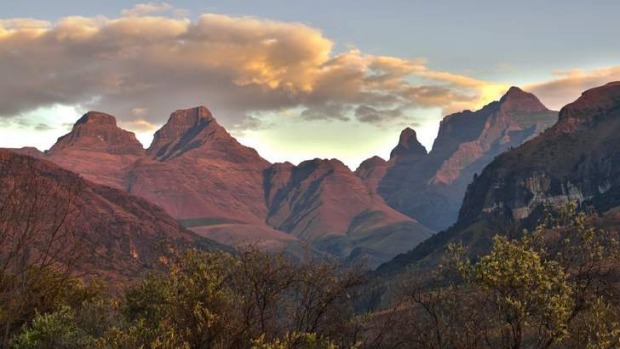
A luxury rail journey delivers stunning scenery and a brutal history.
We're on top of a mountain whose beauty is shrouded in an eerie silence. It's 114 years since its blackest day but this is the bloodiest battleground of the three-year Anglo-Boer War, Britain's costliest, longest and most humiliating conflict since the Napoleonic wars.
The "Acre of Massacre" atop Spioenkop in KwaZulu-Natal's battlefields has a glorious backdrop of Drakensberg Mountains, broad Tugela River and game-rich valleys. Yet the curved trenches and thickets of memorial crosses tell a different story of the horror and futility of Britain's worst single battle as troops tried to relieve the besieged Ladysmith.
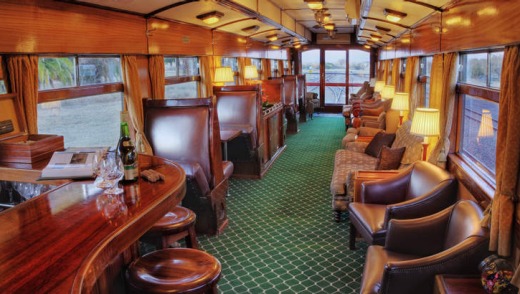
But to start at the beginning, we've come to the battlefields on Rovos Rail's Pride of Africa Pretoria to Durban luxury train. For three days, we're cocooned in comfort - Edwardian reconditioned wood-panelled carriages, personal stewards, silver and starched linen, fine food and wines, generously appointed king-bed suites - returned to a time when the world moved slowly and was "civilised".
But our comfort is juxtaposed against the savage consequences of the clash between British Empire-building and Boer nationalism that cost at least 90,000 people their lives, including about 1000 Australians in our first and longest colonial war, where the rising sun badge was first seen on the slouch hat.
About 20,000 Australians volunteered, forerunners of the Australian Light Horse whose horsemanship was prized against Boer forces with similar skills. Eight Australian VCs were awarded and, rather disgracefully, a Boer War memorial is only now being planned for Canberra's Anzac Parade.
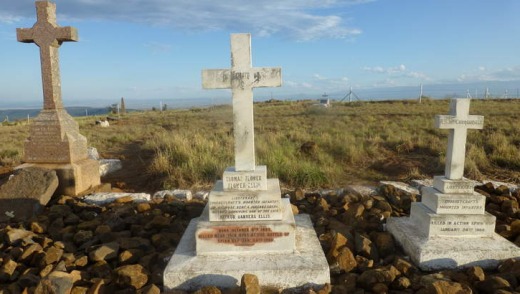
Rovos' train journeys offer more than just a taste of high life. The Durban Safari also has a game drive and art expedition but for us, its battlefields tour provides an understanding of how historic events like the Boer War caused the bitterness that spawned apartheid.
Of course, you are perfectly entitled to relax from the moment you sink into the elegant stuffed furniture of Rovos' Central Park Pretoria private rail station, plied with champagne and tiny sandwiches and introduced to the upcoming red-carpet ride.
But it would be a shame not to plunge headfirst into history as the train travels south-east across gold-rich country, negotiating koppies and cornfields lined with massed pink and white cosmos. It traverses the Drakensberg mountains, known also as uKhahlamba, barrier of spears, into KwaZulu-Natal, finally descending through the loveliest of countrysides, the Valley of a Thousand Hills, to tropical Durban.
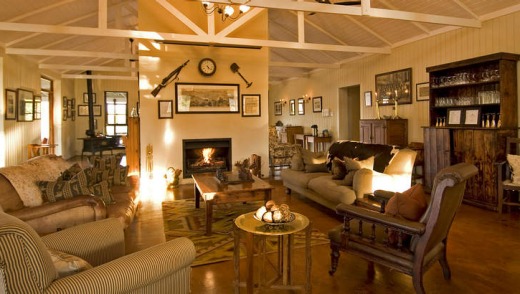
We start in the jacaranda city of Pretoria, ensconced within the plush confines of the Villa Sterne Boutique Hotel and Health Spa. It's an apt beginning as we gaze across the darkening Apies River Valley, nursing our colonial gin and tonics. The war ended in this capital city of the Boer's Transvaal Republic with the signing of the Peace of Vereeneging in 1902.
On the train, lunch accompanies the appearance of the Drakensberg. It's hard not to overindulge with finely composed dishes such as pan-fried line fish with spinach tagliolini and seared loin of springbok with port and black cherry demi-glace, each matched by Cape wines. A person could simply eat, greet (you choose your dining companions), then sleep.
We're here for more. Majuba Hill, site of the Boer victory that ended the first Anglo-Boer War, appears with the advent of high tea in the lounge and observation cars. After Majuba, the British abandoned their target-practice red coats for khaki, though they retained the sense of entitlement that saw them coveting Boer lands once an Aussie discovered gold there in 1886. This launched not just the greatest gold rush but also the second and bloodiest Boer war.
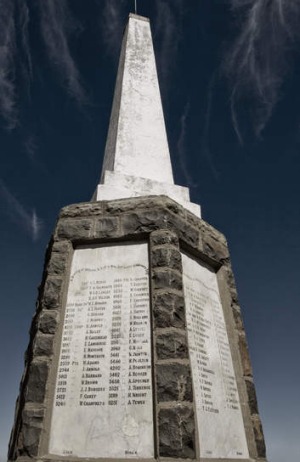
We've just crossed the Mpumalanga border into KwaZulu-Natal. Dinner is served as we pass Glencoe, site of the war's first battle and Elandslaagte is where the train stops for the night. Enjoying a little nightcap from our suite's generously stocked fridge, we read about another Boer victory.
Tomorrow's a big day - a dawn game drive in the malaria-free big five Nambiti Private Game Reserve. As the acacias emerge from early mist, we experience up-close buffalo, kudu, giraffe, a rare sighting of two secretary birds guarding their tree-top nest and a glimpse of black rhino. All this in landscape the Dutch settlers described as "heaven on earth". The Zulu thought so too, hence the Zulu wars, but that's another story.
While we brunch on all manner of goodies including crayfish tails, we slip past Chieveley Siding and the memorial to Winston Churchill, who was captured here.
It's time for our four-hour excursion to Spionkop Lodge. Specialist historian, Raymond Heron takes us to the pinnacle of Mount Alice, across from Spioenkop (also known as Spionkop) where General Buller directed British troops into the battle. Heron delivers a mesmerising account of events from the 1500s to the present, explaining the context of the war and its consequences. I studied all this at school and fell asleep. Not today.
We learn how the Boer commando units, unschooled in warfare, yet remarkable horsemen and excellent shots, especially with their new smokeless Mausers, ran rings around the British. Their three-week war lasted three years.
And yet, their numbers, plus concentration camps and scorched-earth policies, eventually saw the British prevail. A generation of Afrikaners were wiped out, sowing the bitter seeds of modern political history.
Spioenkop looks peaceful across the valley, a lone tree marking the highest point. Three famous men were here, whose deaths would have changed history - Churchill, Mahatma Gandhi and Louis Botha, South Africa's first president.
The next day brings a morning at Ardmore Ceramics in the Natal Midlands. The exuberantly colourful "modern collectables", created by Fee Halsted-Berning and her team of Zulu artists, are sought internationally. A tiny winged zebra now has a new home in Sydney. There's lunch as we traverse the Valley of a Thousand Hills and farewells at Durban Station.
At the Rovos-recommended Fairmont Zimbali Lodge on Natal's Dolphin Coast, 45 kilometres north of Durban, we gather our thoughts. Indigenous vegetation and wildlife surround lodge, built on a magnificent 700-hectare coastal resort, whose Zulu name means "valley of flowers". There's an 18-hole golf course, forest walking tracks, pools, spa and cycle routes. The food is very good (as if we needed more) and we are fortunate to visit on curry night so we can sample supreme Durban Indian cuisine. Thandi restaurant, with its windows framing tropical gardens, is full.
But Rovos' journey has whetted our appetites so from Zimbali, we drive back to Three Trees at Spioenkop in the foothills of the Drakensberg.
We have seen Spioenkop from Mount Alice; now we want to walk on its soil, learning how the British seized defeat from the jaws of victory. Like Raymond Heron, we have heard of Simon Blackburn's prowess as a battlefields raconteur. Blackburn co-owns the lodge with wife Cheryl and they are both experienced safari and mountain guides. After years in remote Africa, they have settled at Three Trees with their children, Kei, Neo, Jos and Cas.
The colonial-style, 18-bedded luxury eco-lodge with its green corrugated roof, wrap-around veranda, fans, beams, vertical cream wood and polished cement floors is built high on a ridge. It's filled with historic memorabilia, battle relics and collections of Africana.
The guest cottages overlook the secluded Mfazimnyama Valley of the game-rich Spioenkop Game Reserve and are set among paperbark acacia and the aloe spectabilis that is the lodge emblem.
Each cottage has a private veranda with spectacular views of the famous mountain - even the bath has views.
They are replicas of the troop accommodation sent in kit form from Britain, plus the Blackburns have thought of every comfort - from the delicious coffee and biscuits to handmade linen embroidered with the red aloe emblem, to fine toiletries, even delightful gowns.
It reflects the hospitality of the staff and the high-quality food from local producers and their own vegetable garden.
There's horse riding, game walks, hiking and mountain-bike trails on offer but the highlight (apart from our walking safari and rhino encounter with Blackburn) is our half-day tour to Spioenkop.
Blackburn brings the battle alive, its ebb and flow, the shallow British trenches that became mass graves, piled four deep, the swarms of flies, terror, intolerable conditions, 38-degree heat, dehydration, shellshock, sunstroke, mismanagement, futility. About 1700 British troops fought, about 600 died and up to 1250 were wounded or missing.
To this day, Liverpool Football Club refers to a part of its ground as "the Kop", in memory of those many Lancastrians who died.
The writer was a guest of Rovos Rail, Three Trees at Spioenkop, Villa Sterne and Fairmont Zimbali Lodge.
TRIP NOTES
GETTING THERE
South African Airways flies from Sydney and Melbourne daily. Fly to Perth with Virgin Australia then SAA to Johannesburg. See flysaa.com.au
STAYING THERE
Rovos Rail's three-day Pretoria-Durban Safari (available in reverse) includes excursions, accommodation, meals and alcohol. From $1459 a person sharing. See rovos.com.
Three Trees at Spioenkop costs $210 a person sharing includes all meals. See threetreehill.co.za
Villa Sterne Boutique Hotel and Health Spa has doubles from $150 with breakfast. See villasterne.com. Fairmont Zimbali Lodge has doubles from $180. See fairmont.com
MORE INFORMATION
country.southafrica.net; battlefieldsroute.co.za